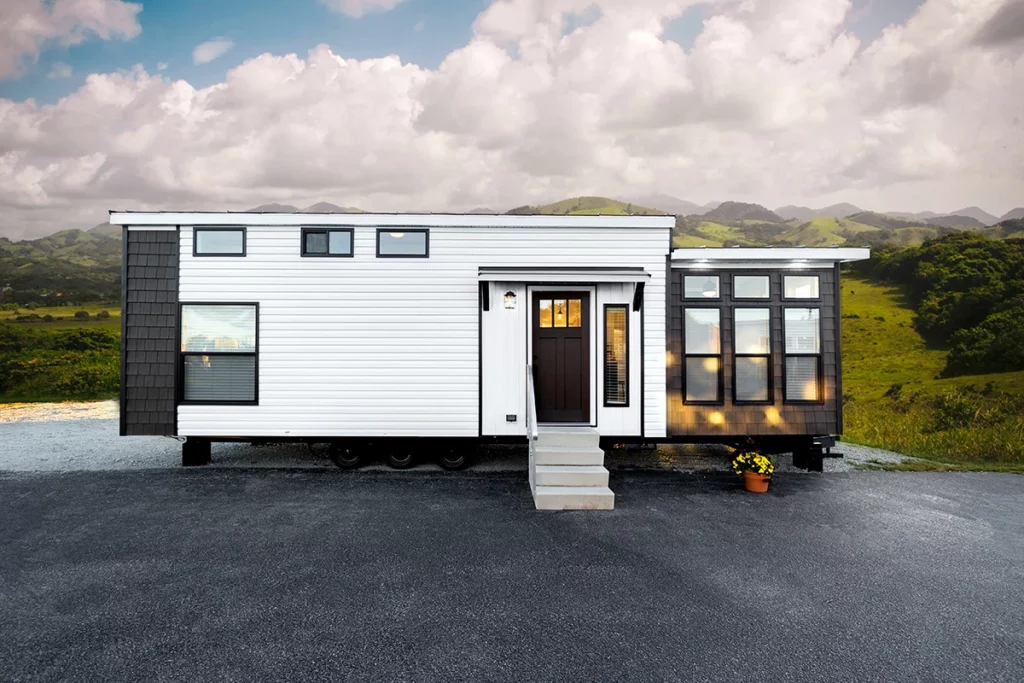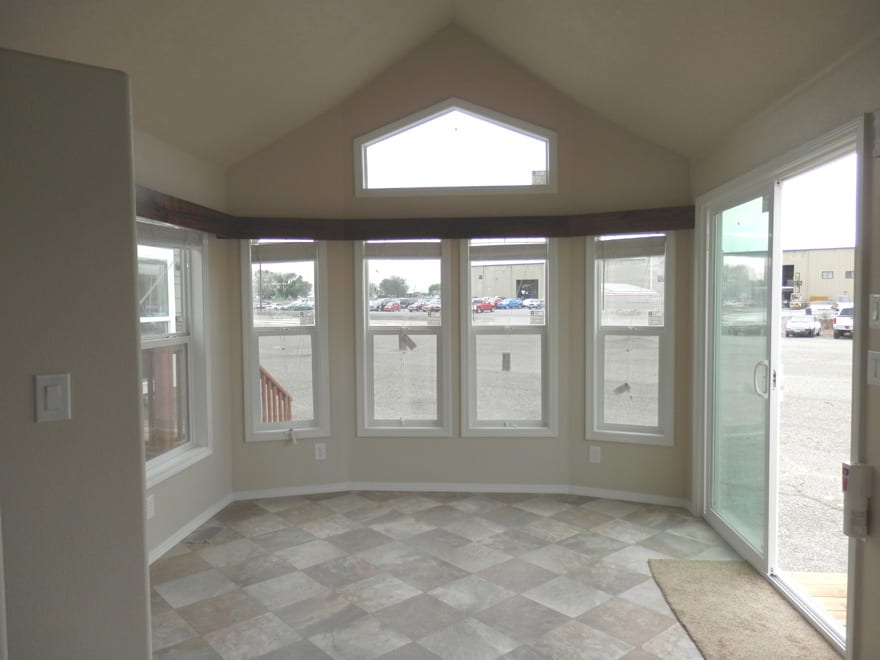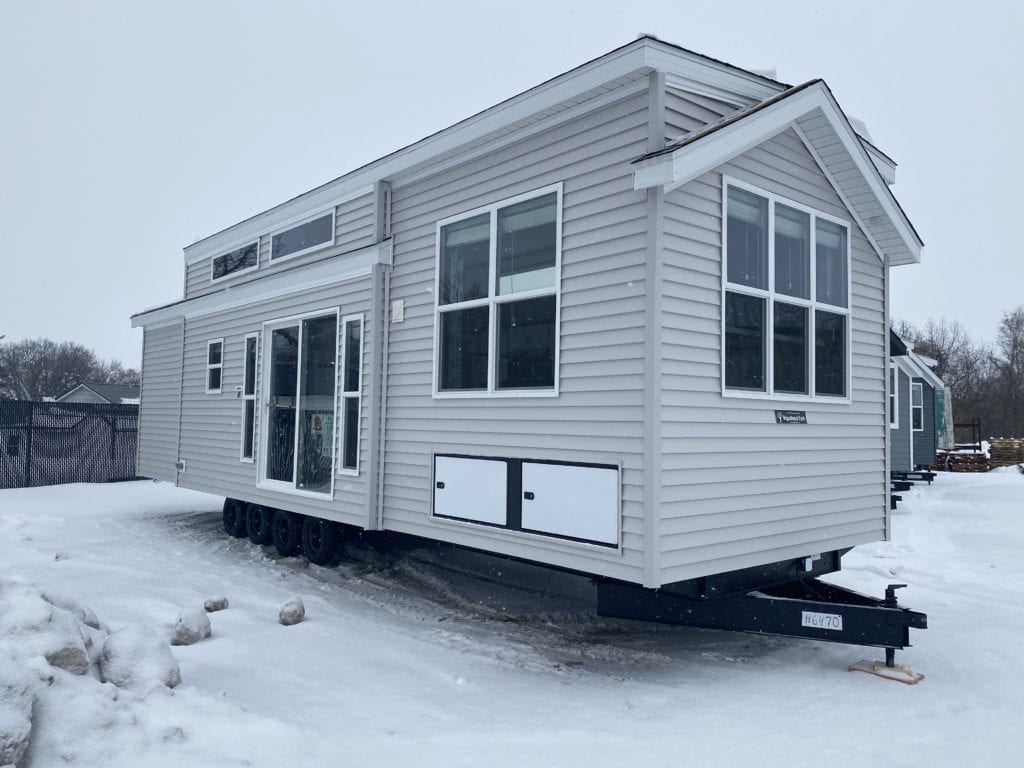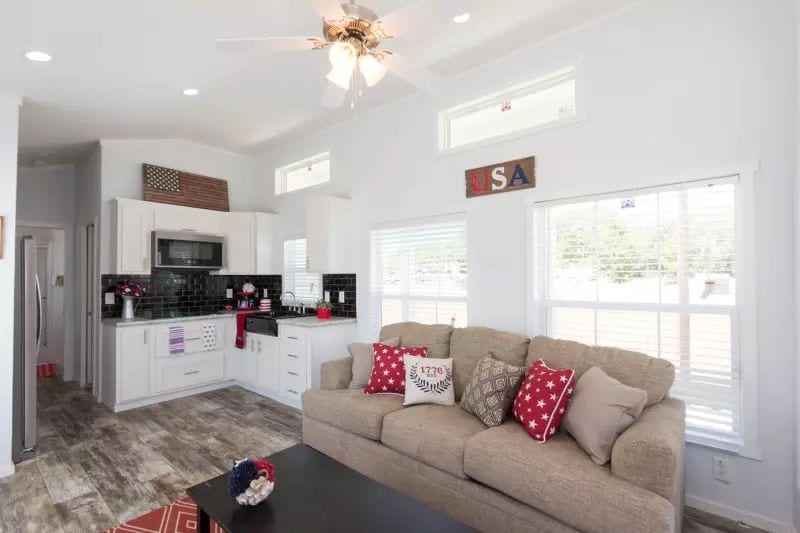If you are looking into how you can live a more sustainable lifestyle, you probably have already experienced some of the effects of climate change. Maybe you have endured summer highs regularly cresting the triple digits, or intense winter storms.
Moving into a tiny house is one way you can make a big reduction in your carbon footprint. Let’s discuss the ways in which tiny home living is more sustainable than living in a traditional full-size home.
- Tiny houses require fewer materials to construct.

Above, you see a photo of the Eldorado 9020, a beautiful modern tiny house measuring 12’ x 34’. That comes out to just 408 square feet. Contrast that with full-size homes, which usually are more than 1,000 square feet, and often more than 2,000 square feet.
The amount of materials that go into a home that is only 400 square feet is substantially less than the amount needed to construct a much larger home. So, tiny houses are less wasteful to build. Many manufacturers also focus on using recycled, reclaimed, and recyclable materials as well to keep their structures as eco-friendly as possible.
- You may rarely need to turn on lights during the day.

Just look at the large windows in the living room of the Athens 509 Loft model. Tiny houses typically are designed with a multitude of large windows like this and an open floor plan that carries natural light throughout the home. As a result, you probably will not need to waste energy turning on lights during the daytime, especially when it is sunny outside.
- Getting a cross-breeze is easy.
Because tiny houses are so small and have so many windows, you can open windows across from each other to get a breeze moving through your home during summer. Using a ceiling fan to help circulate that moving air is often enough to stay comfortable without turning on your air conditioner.
The large windows of a tiny house can also offer some passive solar heating benefits during winter, reducing your need to rely on your heater.
- Less energy is needed to heat or cool your house.

On really hot or cold days, of course, you will probably resort to turning on your heater or air conditioner. But the good news is that you only need to heat or cool about 400 square feet, not 1,000 square feet or more.
Not surprisingly, this takes a lot less energy than you would need to heat or cool a traditional home. Between this and the other benefits we are discussing in this post, that makes a huge difference in emissions. In fact, according to this research, over its lifespan, a tiny house will produce 70% fewer greenhouse gas emissions than a traditional home.
- You can go off the grid.
Imagine if you could get off the grid completely, relying on renewable energy to power your home appliances. That is an option with a traditional home too, of course, but you will find it is easier to go off the grid with a tiny house.
You do not need to generate as much energy for a tiny home, so you do not need as many solar panels, making for a faster, easier and less expensive installation. In some cases, wiring the home for solar might also be simpler and more affordable since the wiring may be more accessible.
- Tiny house living encourages a less wasteful lifestyle.

When you live in a 2,000+ square foot home, you have to purchase enough furnishings and décor to fill up those 2,000+ square feet. Otherwise, your home just looks weirdly empty and uninviting. You probably do not need all those furnishings any more than you need all of that space. In that way, large homes encourage unnecessary consumption and waste.
Contrast that with living in a tiny house. You only will feel compelled to buy the furnishings you really need. In fact, when you buy a home from Park Model Homes, it can include furniture coordinated with the color scheme you select for your interior. You then may not need to purchase any additional furnishings at all.
- Tiny homes make people want to go green.
Finally, the trend toward tiny living is making people excited about the prospect of downsizing and reducing their carbon footprints.
Before tiny homes exploded in popularity, the idea of downsizing did not have mass appeal. Many people thought of it as something one would only do if one absolutely had to for financial reasons.
But less truly can be more, and the tiny movement has proven that time and again. Tiny homes feature beautiful, elegant designs and allow people to simplify their lifestyles and personalize their homes to facilitate living and working the way they truly desire.
As this movement continues to sweep the globe, more and more people will live greener lives. Some will do so because they are embracing sustainability full-on. But others may just end up living more eco-friendly lives because they want to partake of the many other advantages tiny living has to offer.
Either way, the growing trend toward tiny living will create a significant impact. Did you know that traditional buildings produce almost 40% of energy-related carbon emissions worldwide? Tiny houses are helping to reduce those global emissions by replacing those outdated structures with greener alternatives.
Tiny Living is the Sustainable and Affordable Choice
Moving into a tiny house helps you reduce your carbon footprint and material waste, preserving the environment and fighting climate change. And because you use less energy, you also spend less money, resulting in additional cost-saving benefits that add even more value to the tiny lifestyle. If you want to learn more about what makes tiny homes sustainable, or if you are interested in any of the models we have showcased in this post, please contact us.

